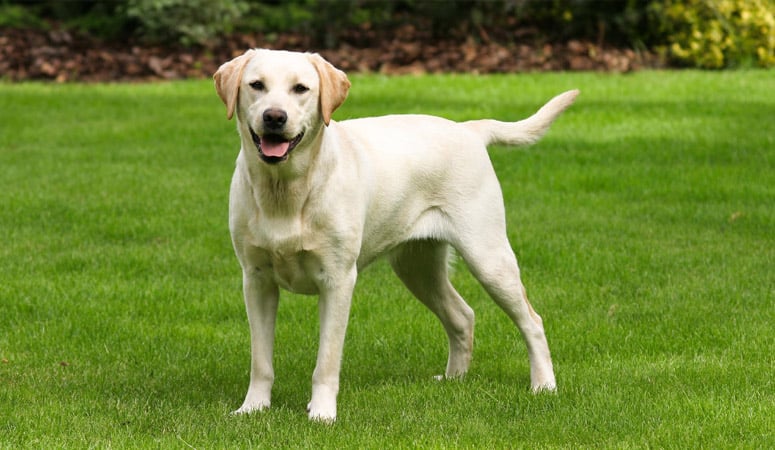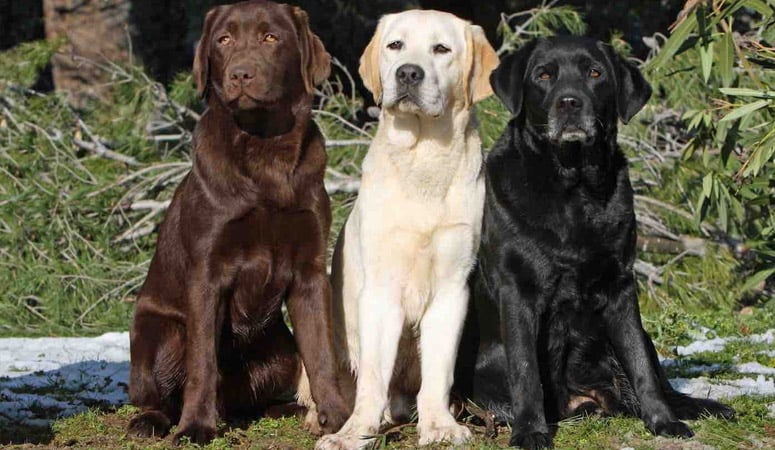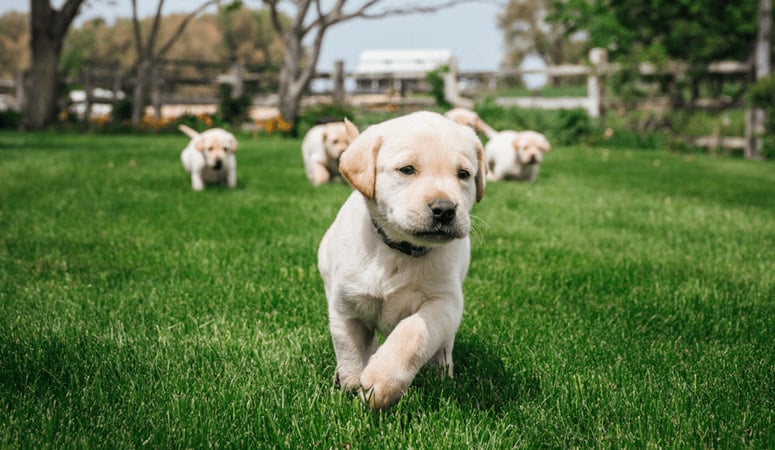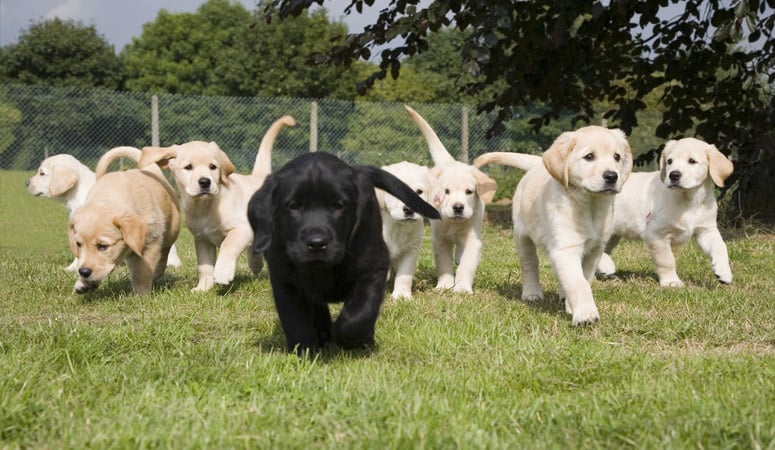Labrador Retriever

The sweety, smart Labrador Retriever is the most popular dog breed, not only in US but also in many countries. The breed is best known for their obedience, loyalty, and cheerfulness. They are gentle, friendly, outgoing, and high-spirited companions who have more than enough affection to go around for a family.
| Other Names | Lab |
| Color | Yellow, Black, Chocolate |
| Height | Male: 22-25 inches. Female: 21-24 inches. |
| Weight | Male: 65-80 pounds. Female: 55-70 pounds. |
| Life Span | 10-12 years |
| Personality | Active, Friendly, Outgoing |
| Exercise | Needs Lots of Activity |
| Origin |
| Popularity | #1 |
| Groom Needs | Weekly |
| Kids Friendly | Yes |
| Dog Friendly | Yes with supervision |
| Watch Dog | |
| Family Dog | Yes |
| Litter Size | 5–10 |
Labrador Retriever Pictures
Labrador Retriever Video
Introduction
The Labrador Retriever is well known as one of the best general purpose dogs and as a good family companion. It is almost the most popular dog breed in America. It is available in three colors: yellow, black and chocolate, known for their gentle and loving behavior. Lab is an amazingly calm dog. It looks forward to praise and positive attention, in part because they are considered one of the fastest-learning dog breeds: making training a very rewarding experience. Because of its pronounced sense of smell, it is often used by law enforcement agencies to prove drugs. This work dog is also used for rescue operations and is a worldwide choice for guide programs. The Labrador Retriever is large, however the height and weight of an adult is different. Depending on the color of the coat, eye color varies from dark brown to medium brown. Labrador lose their hair all year long, and their short thick braided layers are waterproof enough to provide protection from water and weather. Combined with spotted skin and a nut-like tail, Labs are natural swimmers. Most Labradors love to swim and play in the water.
Living with Labrador Retriever
Your labs need a bath about every two months or so to keep them having a clean appearance and smelling good.
Grooming of a lab is easy. However labs shed a lot. You’ll need a vacuum cleaner and brush your lab daily, especially when they’re shedding.
Shaving a Labrador Retriever is not recommended.
In order to remove tartar buildup and the bacteria that lurk inside it, you may need to brush your dog’s teeth two or three times a week.
Trim nails once or twice a month if your dog doesn’t wear them down naturally. When you hear them clicking on the floor, it means your dog needs their nails trimmed.
Since Labrador Retrievers are smart and active, they need daily mental and physical exercise. Because of their high energy level, exercise should be plenty. Overeating and obesity can be a concern for a lab, so regular exercise will help maintain a proper weight. Lab can be a calm housedog if given adequate exercise.
Try playing with toys that promote activeness and exercise.
Running, swimming, retrieving, and hiking are all favored activities for Lab. Try to keep at least 45 minutes of exercise daily.
Field-bred Labs are lighter built and more active than show-bred Labs, and will usually require more exercise.
Proper nutrition helps Keep health of your Labrador Retriever. Because Labradors have a tendency to become obese, knowing how much food to feed a Labrador Retriever is as important as what to feed a Labrador Retriever. Keeping them at a healthy weight will make them live longer and have fewer health problems, for example, arthritis, according to studies.
Puppies should be fed a large-breed growth food. This will slow their growing rate but not final size. This has been shown to decrease the occurrence or severity of hip dysplasia in adults. Use a feeding chart as a guide, or ask your veterinarian how much to feed your puppy. Adult dogs should have a balanced diet that keep them from becoming overweight.
If you would like to cook at home or feed raw, better consult with a veterinary nutritionist to get a complete and balanced diet first.
Suggested tests: hip, elbow, eye, knee, exercise-induced collapse (DNA), centronuclear myopathy
Major concerns: CHD, elbow dysplasia, OCD, obesity, patellar luxation, Joint Dysplasia, Skin Allergies and Infections
Minor concerns: cataract, CPRA, hot spots, hypothyroidism, Ear Infections
Occasionally seen: diabetes, entropion, distichiasis, tricuspid valve dysplasia, centronuclear myopathy, exerciseinduced collapse, eye disorders
Total Annual Cost: $3120
Cost is estimated for the first year and may vary depending on many factors, such as dog food, health care, leash, collar, licensing, possible fencing, crates, training and obedience classes, dog-walking, grooming, treats, toys, flea, tick, and heart-worm meds, microchips, etc.
Labrador Retriever is considered an easy-to-train breed. The Lab’s easygoing nature and ability to learn make it a desirable dog breed. Lab does best with reward-based training involving food or retrieving.
Since Labs have strong physical strength and high energy level, early socialization and puppy training classes are needed. Gently exposing the puppy to a wide variety of people, places, and situations between the ages of 7 weeks and 4 months and beginning obedience training early on will make them a well-adjusted, well-mannered adult.
Labs are devoted, intelligent, and enthusiastic companions who need to be included in family activities. Dock diving is an exciting, low-impact sport that the water-loving Labrador enjoys. They also need mental exercise in the form of training or games.
History
Labrador is not a very old breed of dog. They originated in Newfoundland, Canada, in the 19th century. Dogs were created as a cross between small water dogs and Newfoundland. This led to the fact that the dogs were called “St. John” water dogs. These dogs were large retreats and were seen by the Earl of Malmesbury, who imported some of them into the UK.
The ancestors of the St. John water dog were descended from rock-like dogs that had been brought to the region by Portuguese fishermen for decades and mixed with breeds from England and Ireland. They were interbred with setters and spaniels, as well as other restorations, to hone their recovery skills. Their gentle nature makes them suitable for various roles.
Only when the dogs were brought back to Poole, England, did the nobility turn them into coveted waterfowl. It was believed that the breed arrived in the British Isles at the end of the 19th century from Colonel Peter Hawker and Earl of Malmesbury. His dog “Malmesbury Trump” was one of the means of founding the breed.
When they arrived in England, they were given the name “Labrador”, which followed the area known as the Labrador Peninsula. It is part of Newfoundland and Labrador in Canada. The state was named after the Portuguese explorer João Fernandez Lavrador, who gave him his name in 1498. “Lavrador” was a name that he could use as a landowner and literally meant “landowner.” Thus, the roots of the name Labrador can be found in the Portuguese name of the 15th century.
Labrador were first recognized by the Kennel Club of Great Britain in 1903 and the American Kennel Club in 1917. The Labrador has enjoyed continuous popularity for much of the twentieth century, and the Labrador has grown steadily over the past two decades.
Helpful Information
Breed Club: THE LABRADOR RETRIEVER CLUB, INC.
Breed Club Link: https://thelabradorclub.com/
Breed Club Rescue:
Breed Club Rescue Link: https://thelabradorclub.com/breeders-rescue-groups/rescue-organizations/




